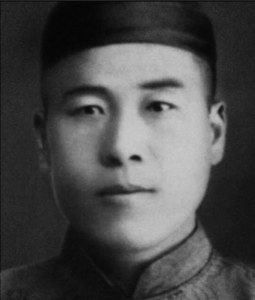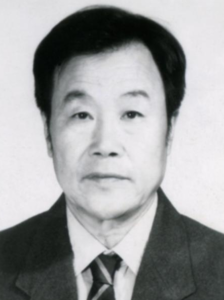Pi Gua Quan (Hacking and Hanging Fists), is also known as Gua Quan, Pi Gua Zhang, Mo Mian Quan and Po Gua Quan is said to date back to the Ming Dynasty. In the Ming dynasty General Qi Jiguang’s (1528-1587) “Jixiao Xinshu” written approximately in 1560 AD state “Pi Gua Heng Quan ri qi Kuai Ye” (Pi Gua horizontal Fist, is also very fast). It is likely that this same reference is to Piguaquan. The Pi there referred to wearing of armour, whilst Gua and Heng are techniques/concepts. Since then the art was mainly found in the Qing dynasty and has evolved into two key branches.
In Nanpi County, just south west of Cangzhou, a legendary Master named Guo Dafa taught Piguaquan. Originally known as Guo Qinfa, due to his large and tall stature, he was later known as Guo Dafa (Da meaning Big). Guo Dafa was from the Dalongzhuang village in Nanpi County. As a result of his formidable skills, early in his life Guo Dafa had become a bodyguard to the imperial court and is said to have impressed the emperors so much that he was asked to teach some martial arts to the imperial family. During his later years he retired back to his hometown and passed his skills to his son Guo Changrong and grandson Guo Xiuting as well as members of the Zhao family in Zanzhuang (village). This was kept within Zhao family members until the 3rd generation, Zhao Shikui who then taught Guo Changsheng (郭长生 1896-1967). The key sets from Nanpi were Pigua Kuaitao (Pigua fast set), Guaquan (Hanging fist) and Paochui (Cannon Strikes).

Guo Changsheng in 1916 joined the warlord, Cao Kun (曹錕), in Baoding. During that time, Guo along with the other solders studied under Ren Xiangrong (任向荣 1852-1930) and Liu Yuchun (1878-1932), whom were both experts of Taizu Men Duliu Tongbei Quan (太祖门独流通背拳) having studied under M. Li Dengshan (李登善). It was during those years that Guo Changsheng learnt the Taizu Long Boxing, 24 methods, Taizu Staff and Miao Dao, this greatly enhanced Guo’s skills beyond Piguaquan.
who was said to have studied with a wanderer surnamed Han (no firstnames given) the skills was the key inheritor of Piguaquan. Zuo Baomei was both a skilled martial artist but also of high ethics, thus people respectfully referred to him as “Zuo Ba Ye” (8th Elder Zuo). Zuo Baomei passed on the skills to Pan Wenxue (also named Shikui) who taught civil and military lectures in college. Two were very outstanding students, Li Yunbiao and Xiao Hecheng and as a result, Pan Wenxue taught them Piguaquan. Both were outstanding and Xiao Hecheng was so great at his footwork and dodging manoeuvres that he was nicknamed “Flying Body Xiao”. Xiao Hecheng in his later years taught Huang Lin biao, Wang Zhengyi and Yu Baolin. Huang Lin biao taught the two famous Ma brothers – Ma Fengtu (1886-1973) and Ma Yingtu (1889-1956). They key sets from Yanshan were Pigua Mantao (Pigua slow set) and Qinglongquan (Green Dragon Fist).
Dissemination of Pigua Quan
Since both Guo Changsheng and Ma Yingtu, were given coaching positions in 1928 at the Nanjing National Martial Arts Association, they mutually exchanged from each other the various aspects of the different Piguaquan. Thus their lines brought the two evolutions (5 sets) back together. They also researched and further improved the system including the addition of weapon sets/methods – Pigua Dao (Pigua broadsword), Miao Dao and Fengmo Gun (Crazy Devil Staff). When both left the Nanjing assocation they taught Piguaquan in their respective places. Guo Changsheng taught in the Cangzhou regions and Ma Yingtu taught in the North West (Gansu province).

In Cangzhou, the contents consisted of Pigua Kuaitao (Pigua fast set), Pigua Mantao (Pigua slow set), Qinglongquan (Green Dragon Fist), Guaquan (Hanging fist) and Paochui (Cannon Strikes). In Gansu, the contents consisted of Pigua (also known as Mo Mian Quan), Qing Long (Green Dragon), Fei Hu (Flying Tiger) and Tai Shu (highly refined).
Since both Guo Changsheng and Ma Yingtu had studied other martial arts, each added aspects and features from those arts into their teachings. As an example in Guo Changsheng in Cangzhou would teach his Tong Bi Quan methods, whilst Ma Yingtu in Gansu had his 12 Large sequences and 10 roads of Ma family Tantui. However, in general the Piguaquan contain similar features.
Ma Yingtu along with his elder brother taught their children Ma Yingda, Ma Xianda, Ma Lingda and Ma Mingda as well as disciples Wang Tianpeng, Luo Wenyuan and Ma Chengzhi. Exchange with Ma Yingtu’s Bajiquan teacher Li Shuwen, introduced a set into that line of Bajiquan. Guo Changsheng taught his disciples Cao Yanhai, Guo Jianwei, Gao Yuqing, Niu Senghua and his two children Guo Ruilin and Guo Ruixiang.
Curriculum of Taiping Piguaquan
Piguaquan has been recently adopted into the Taiping curriculum due to the ongoing interaction with Cangzhou martial arts. Originally Piguaquan was just a part of Taiping Bajiquan but over the last 6 years ongoing training into the specific Pigua Men systems of Cangzhou city, Yanshan and Nanpi counties the greater Piguaquan system has been inherited.
It is said that Piguaquan was designed to be able to fight with full armoured gear, therefore the movements are wide and open and include large body angles and adjustments to account for the interference such armory could produce. However in that same way it has developed specialised ways of applying power and its strikes often in full swing can be both fast and deadly effective.
There are many exercises to ensure that the back, waist, arms, shoulder, etc.. are conditioned properly to move freely and execute the power required. This include stretches and swinging motions, which inevitably are sometimes techniques in Piguaquan which is why sometimes it is said that exercise and combat are complementary in Piguaquan. There is a focus on the waist generating power and then the chest, back support the Tuntu (spitting and swallowing power) and Kai He (opening and closing) as well as the ability to fold arms that are then propelled into linked techniques. The joints and limbs must be both flexible and relaxed only then will power be developed. Inn terms of power development, Pigua encompasses Swinging power, Swaying Power, Spit/swallow Power, Rolling Power and Passing through Power.
Since stepping is of importance the two main methods of Zhan Zhuan Bu (Turning Steps) and Lian Huan Bu (Continuous Steps) are focused on which are later combined with basic techniques such as Yuan Di Chuan Shou (Earth Originating Thrusting Hands), Lianhuan Bu Pi Lou Shou (Continuous Step Chopping pass over hands), Dan Pi Shou (Single Chopping Hands) and Pi Zhang (Chopping Palms) as examples. The 18 character key for motions of Piguaquan include gun (rolling), Le (hold back), pi (hacking), Gua (hanging), Zhan (Chop), Xie (remove), Jian (scissor), Cai (pluck), Lue (Plunder), Bin (reject), Shen (Stretch out), Shou (Retract in), Mo (Rub), Tan (explore), Dan (Spring out), Za (Smash Hammer), Lei (beat), Meng (Ferociously).
Piguaquan was originally known for the 12 main methods (for example Single Splitting palm, Open the Door Cannon, Iron Broom, Double Crushing palms, Smashing Hammer, Large Step, Wrapped hands, Thrusting Palms, Locked arms extracting pearls, Through the forest and so on). These differ depending on lineage, so there are other varieties. The key sets of Pigua Quan include the following:
- Liu Tui Shi (溜腿势)
- Pigua Quan (劈挂拳)
- Qinglong Quan (青龙拳)
- Gua Quan (挂拳)
- Pao Chui (炮拳)
Piguaquan was not known for its weapons and the majority of its well known weapons were derived from Taizu Men in the early years and also Erlang Quan later. The Miao Dao used to consist of eight methods, which were later expanded by Ren Xiangrong and Liu Yuchun into 12 methods. This became the basis of Guo Changsheng’s First Road of Miao Dao. Later in the Nanjing Academy together with Ma Yingtu the set was further changed and became known as the Second Road of Miao Dao. There is also the Pigua Dao (Saber) which is derived from the Taizu Tongbei Tiangang Saber. The Fengmo staff was created on the basis of the Taizu Staff from Taizu Men. The key weapons of Pigua Quan include the following:
- Feng Mo Gun (风魔棍 Staff)
- Miao Dao (苗刀 Will leaf Saber)
- Pigua Dao (劈挂刀)
- Qimen Qiang (奇门枪 Spear)
- Meihua Qiang (梅花枪 Spear)
- Heihu Bian (黑虎鞭 Rod)
